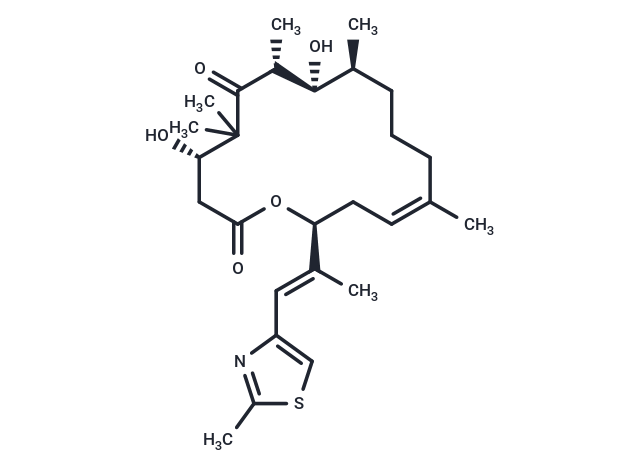Shopping Cart
- Remove All
 Your shopping cart is currently empty
Your shopping cart is currently empty

Epothilone D (KOS 862) is a potent microtubule stabilizer.

| Pack Size | Price | Availability | Quantity |
|---|---|---|---|
| 5 mg | $970 | 6-8 weeks | |
| 50 mg | $1,850 | 6-8 weeks | |
| 100 mg | $2,500 | 6-8 weeks |
| Description | Epothilone D (KOS 862) is a potent microtubule stabilizer. |
| In vitro | Epothilone D is a more potent microtubule stabilizer in vitro than epothilone A or B. In vitro, Epothilone D has shown potent cytotoxicity in a panel of human tumor cell lines, with similar potency to paclitaxel. Epothilone D also shows a definite advantage over paclitaxel in drug-resistant cell lines and retained its cytotoxicity against a multidrug-resistant cell line over-expressing P-glycoprotein [1]. |
| In vivo | To evaluate whether Epothilone D improves MT and axonal function in PS19 mice, groups of 3-month old male PS19 mice received weekly i.p. injections of vehicle or Epothilone D (1 mg/kg or 3 mg/kg) for a total of 3 months. In addition, 3-month old non-Tg littermates received 3 mg/kg Epothilone D or vehicle. The 3 mg/kg Epothilone D dose corresponds to ~10-fold less than that used in Phase II clinical study, which should minimize side-effects such as neutropenia that are observed with MT-stabilizing drugs in human subjects. PS19 and WT mice that receive Epothilone D show no signs of drug intolerance. Indeed, all drug-treated mice exhibited weight gain that is indistinguishable from vehicle-treated animals. Likewise, relative organ weights are similar in vehicle- and Epothilone D-treated mice. The motor performance of Epothilone D-treated mice, assessed using a standard rotarod test, is not significantly different from vehicle-treated cohorts [2]. |
| Animal Research | Groups of mice (n=3) receive intraperitoneal (i.p.) injections of 3.7 mg/kg of Epothilone D (epoD) dissolved in 100% DMSO, followed by euthanization using approved at times ranging from 0.25 h to 24 h. In another study, groups of mice (n=3) receive injections of 3 mg/kg of epoD in 100% DMSO followed by euthanization 4, 6 and 10 days later. The Epothilone D (epoD) levels in the brain and blood samples are determined using LC-MS/MS protocols. Groups (n=10-13) of 3-month old PS19 tau Tg mice or 3-month old non-Tg littermates are administered weekly i.p. injections of 1 mg/kg epoD, 3 mg/kg of Epothilone D (epoD) or vehicle (DMSO), for a total of 3 months. Animals are monitored for signs of abnormal behavior or distress and are weighed weekly. After final dosing, the mice undergo motor function and cognitive testing. After euthanization, brains and optic nerve (ON) are recovered for immunohistochemical analyses. A subset of mice from each group also undergo necropsy evaluation with organ weights recorded [2]. |
| Alias | KOS 862 |
| Molecular Weight | 491.68 |
| Formula | C27H41NO5S |
| Cas No. | 189453-10-9 |
| Relative Density. | 1.084 g/cm3 (Predicted) |
| Storage | Powder: -20°C for 3 years | In solvent: -80°C for 1 year | Shipping with blue ice. | |||||||||||||||||||||||||||||||||||
| Solubility Information | DMSO: 300 mg/mL (610.15 mM), Sonication is recommended. | |||||||||||||||||||||||||||||||||||
Solution Preparation Table | ||||||||||||||||||||||||||||||||||||
DMSO
| ||||||||||||||||||||||||||||||||||||

Copyright © 2015-2025 TargetMol Chemicals Inc. All Rights Reserved.